Category: Powder Coat Guide
Do you have powder coating questions about powder coating equipment,powder application,powder material?Do you have any doubt about your powder coat project, here a complete powder coat guide may help you find the satisfactory answer or solution.
The use of epoxy electrically conductive putty
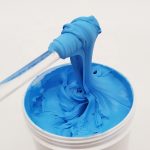
Conductive putty Intended Uses Used to repair and fill up the floor surface before painting with antistatic finish in order to provide smooth conductive surface for next coat. Product Information conductive putty can be applied by doctor blade. Thick film may be obtained. After drying, no contraction or crack takes place to the film. Easy to be applied.The film possesses good adhesion, high strength, and small electric resistance. Its apperance is smooth. Application details Volume Solids:90%Color:BlackDry Flm Thickness: Depending onRead More …
Bending Test – Qualicoat Testing Process
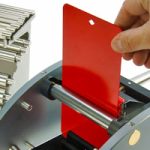
All organic coatings except class 2 and 3 powder coatings: EN ISO 1519 Class 2 and 3 powder coatings: EN ISO 1519 followed by a tape pull adhesion test as specified below: Apply an adhesive tape to the significant surface of the test panel following the mechanical deformation. Cover the area by pressing down firmly against the coating to eliminate voids or air pockets. Pull the tape off sharply at right angles to the plane of the panel after 1Read More …
What Hazardous chemicals in powder coating process
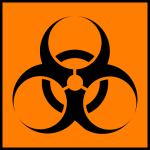
Triglycidylisocyanurate (TGIC) TGIC is classified as a hazardous chemical and is commonly used in powder coating activities. It is: a skin sensitiser toxic by ingestion and inhalation genotoxic capable of causing serious eye damage. You should check SDSs and labels to determine if the powder coat colors you are using contains TGIC. Electrostatic powder coating containing TGIC are applied by electrostatic process.Workers who may come into direct contact with TGIC powder coatings include persons: filling hoppers manually spraying powder paint,Read More …
How To Powder Coat
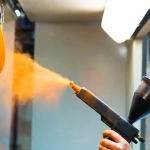
How to powder coat : pre-treatment – drying to remove water – spraying – Check – baking – check – Finished. 1.The characteristics of the powder coating can give full play to extend the coating life to break the painted surface first strictly surface pre-treatment. 2.Spray, was painted to be fully grounded in order to increase the efficiency of the powder coating of puffing. 3.The larger surface defects to be painted, coated scratch conductive putty, in order to ensure theRead More …
Cross Cut Test ISO 2409 Renewed
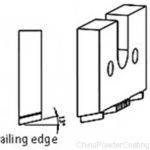
The ISO 2409 Cross Cut Test has been recently updated by ISO. The new version that is now valid has several changes compared to the old one: Knives The new standard includes an enhanced description of the well-known knives.The knives need to have a trailing edge, because otherwise it skates instead of scratches. Knives that do not have this trailing edge are not according to the standard. Tape The new version of the standard has a huge change compared toRead More …
what is Powder Coating MSDS
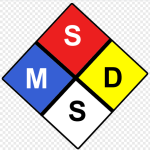
Powder Coating MSDS 1. CHEMICAL PRODUCT AND COMPANY IDENTIFICATION PRODUCT NAME: Powder Coating MANUFACTURE/DISTRIBUTOR: Jinhu Color Powder Coating Co., Ltd Address: Dailou Industrial Zone,Jinhu County,Huai’an,China Emergency Response Call: 2. COMPOSITION/INFORMATION ON INGREDIENTS HAZARDOUS INGREDIENTS : CAS No. WEIGHT (%) Polyester resin : 25135-73-3 60 Epoxy resin : 25085-99-8 20 Barium sulfate: 7727-43-7 10 Pigments: N/A 10 3. HAZARDS IDENTIFICATION Primary Routes of Exposure : Skin Contact,Eye Contact . Inhalation :Inhalation of dust or mist caused during heating and processing can cause irritation of nose, throat and lungs,headache,nausea Eye Contact :Material can cause irritation Skin ContactRead More …
What Is Powder Coatings Manufacturing Process
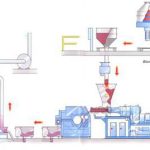
Powder Coatings Manufacturing Process The process of powder coatings production includes the following steps: Distribution of raw material Pre-mixing of raw material Extrusion (mixing of melted raw materials) Cooling and crushing the extruder’s output Grinding , classifying, and controlling of the particles Packaging Pre-mixing of raw materials In this step, the distributed raw materials of each production unit will be mixed based on the guidelines and formulization of research and development unit in order to have a homogeneous mixture underRead More …
Powder coatings curing process in the Oven
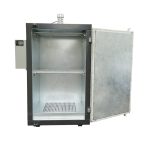
Powder coatings curing process in the oven consists of three stages. First,the solid particles are melted,then they combine together ,and finally they form a uniform film or coating over the surface . Maintaining low viscosity of the coating for an adequate time is very significant to have a smooth and even surface. Having decreased during the curing process, viscosity tends to increase as soon as the reaction (gelling )begins. Thus ,reactivity and heat temperature have a significant role in creatingRead More …
Procedure for X-CUT TAPE TEST METHOD-ASTM D3359-02
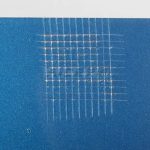
Procedure for X-CUT TAPE TEST METHOD-ASTM D3359-02 7. Procedure 7.1 Select an area free of blemishes and minor surface imperfections. For tests in the field, ensure that the surface is clean and dry. Extremes in temperature or relative humidity may affect the adhesion of the tape or the coating. 7.1.1 For specimens which have been immersed: After immersion, clean and wipe the surface with an appropriate solvent which will not harm the integrity of the coating. Then dry or prepareRead More …
Standard Test Methods for Measuring Adhesion by Tape Test
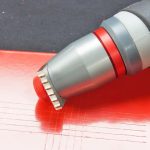
Test Methods for Measuring Adhesion This standard is issued under the fixed designation D 3359; the number immediately following the designation indicates the year of original adoption or, in the case of revision, the year of last revision.A number in parentheses indicates the year of last reapproval. A superscript epsilon (e) indicates an editorial change since the last revision or reapproval. 1. Scope 1.1 These test methods cover procedures for assessing the adhesion of coating films to metallic substrates byRead More …
Prevention of powder coating orange peel
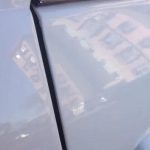
Prevention of powder coating orange peel The appearance of the coating is becoming increasingly important in the new equipment manufacturing (OEM) Painting. Therefore, one of the main objectives of the coatings industry is to make the final requirements of the user paints to achieve the best performance, which also includes the surface appearance of satisfaction. Affect the visual effects of the surface condition by the factors such as color, gloss, haze, and surface structure. The gloss and image clarity isRead More …
Classification of Adhesion Test Results-ASTM D3359-02

Inspect the grid area for removal of coating from the substrate or from a previous coating using the illuminated magnifier. Rate the adhesion in accordance with the following scale illustrated in Fig. 1: 5B The edges of the cuts are completely smooth; none of the squares of the lattice is detached. 4B Small flakes of the coating are detached at intersections; less than 5 % of the area is affected. 3B Small flakes of the coating are detached along edgesRead More …
TEST METHOD-CROSS-CUT TAPE TEST-ASTM D3359-02

TEST METHOD-CROSS-CUT TAPE TEST-ASTM D3359-02 10. Apparatus and Materials 10.1 Cutting Tool9—Sharp razor blade, scalpel, knife or other cutting device having a cutting edge angle between 15 and 30° that will make either a single cut or several cuts at once. It is of particular importance that the cutting edge or edges be in good condition. 10.2 Cutting Guide—If cuts are made manually (as opposed to a mechanical apparatus) a steel or other hard metal straightedge or template to ensureRead More …
Use of Zinc Rich Primer for steel and ferrous metals
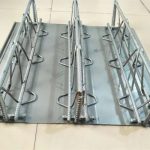
Use of Zinc Rich Primer for steel and ferrous metals Zinc Rich Primer is an organic zinc rich primer for steel and ferrous metals that combines the resistance properties of epoxy and the galvanic protection of zinc.This is a pure zinc epoxy base one-package primer. This high performance epoxy compound fuses zinc to the metal substrate and protects against corrosion equal to Hot Dip Galvanizing (meets and exceeds ASTM A780 specification for touch-up and repair of Hot Dip Galvanize). ClearcoRead More …
Optimal Performance of UV Powder Coatings
Powder coating cured by ultraviolet light (UV powder coating) is a technology that combines the advantages of thermosetting powder coating with those of liquid ultraviolet-cure coating technology. The difference from standard powder coating is that melting and curing are separated into two distinct processes: upon exposure to heat, UV-curable powder coating particles melt and flow into a homogeneous film that is crosslinked only when it is exposed to UV light. The most popular crosslinking mechanism used for this technology isRead More …
Methods are used to capture overspray during powder coating
Three basic methods are used to capture over sprayed powder coating powder:Cascade (also known as a water wash),Baffle, and Media filtration. Many modern high volume spray booths incorporate one or more of these methods of source capture in an effort to improve overall removal efficiency. One of the most common combination systems, is a cascade style booth, with multi-stage media filtration, prior to the exhaust stack, or prior to a VOC control technology like an RTO (regenerative thermal oxidizer). Anyone that looks behindRead More …
What is Manganese phosphate coating
Manganese phosphate coating has the highest hardness and superior corrosion and wear resistances of general phosphate coatings. Manganese phosphating is extensively employed to improve the sliding properties of engine, gear, and power transmission systems. The use of manganese phosphated coatings for improved corrosion resistance can be found in virtually all branches of the metal working-industry. Typical examples mentioned here include motor vehicle components in brake and clutch assemblies, engine components, leaf or coil springs, drill bits, screws, nuts and bolts,Read More …
Zinc phosphate and its applications
Generally zinc phosphate conversion coating is used to provide long lasting corrosion protection. Almost all automotive industries use this type of conversion coating. It is suitable for the products come against hard weather conditions. Coating quality is better than iron phosphate coating. It forms 2 – 5 gr/m² coating on the metal surface when used as under paint. Application, set up and control of this process are more difficult than other methods and can be applied by immersion or spray.Read More …
What is Zinc Phosphate Coatings
Zinc phosphate coating is preffered in case of requirement of higher corrosion resistance than iron phosphate. It can be used as base for paintings (especially for thermosetting powder coating), before cold drawing / cold forming of steel and prior application of protective oil / lubrication. This is often the method chosen when long life under corrosive conditions is required. Coating is also very good with zinc phosphate because the crystals form a porous surface which can soak up and mechanicallyRead More …
What is Phosphate coatings
Phosphate coatings are used to increase corrosion resistance and improve powder paint adhesion,and are used on steel parts for corrosion resistance, lubricity, or as a foundation for subsequent coatings or painting.It serves as a conversion coating in which a dilute solution of phosphoric acid and phosphate salts is applied via spraying or immersion and chemically reacts with the surface of the part being coated to form a layer of insoluble, crystalline phosphates.Phosphate conversion coatings can also be used on aluminium,Read More …
Fluid Bed Powder Coating Application Process
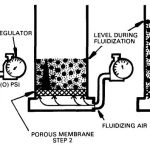
Fluid bed powder coating consists of immersing a hot part into a bed of powder, allowing the powder to melt on the part and build a film, and subsequently providing enough time and heat for this film to flow into a continuous coating. The part should be immersed in the fluidized bed as quickly as possible after removing it from the preheat oven to keep heat loss at a minimum. A time cycle should be established to keep this timeRead More …
What are the common fluidized bed powder coating process parameters?
There are no common parameters in the process of fluidized bed powder coating since it changes dramatically with part thickness. Two-inch thick bar stock can be coated with functionalized polyethylene by preheating to 250°F, dip coated and will most likely flow out without any post heating. Conversely, thin expanded metal may have to be preheated to 450°F to achieve the desired coating thickness, and then post heated at 350°F for four minutes to complete the flow out. We have neverRead More …
Brief introduction of fluidized bed powder coating
The fluidized bed powder coating system has three main sections. A top powder hopper where the powder is held, a porous plate which allows air to pass through, and a sealed bottom air chamber. When pressurized air is blown into the air chamber it passes through the plate and causes the powder to float or “fluidize”. This allows the metal part to be coated to be moved through the powder with little resistance. Fluidized bed application is accomplished by preheatingRead More …
Acrylic hybrids combine the acrylic resin with an epoxy binder.
They are somewhat better than a epoxy-polyester / hybrid but still not considered acceptable for outdoor use. The mechanical properties that are characteristic in epoxies are a benefit of these materials and they have much better flexibility than other acrylics. Because of their good appearance, tough surface, exceptional weatherability, and excellent electrostatic application characteristics, acrylics are frequently used for applications on products that have very high quality standards. Appliances, automobiles and other products that require durability and long life inRead More …
Adhesion problem of powder coating application
Poor adhesion is usually related to poor pretreatment or under cure. Undercure -Run an electronic temperature recording device with a probe on the part to ensure that the metal temperature reaches the prescribed cure index (Time at temperature). Pretreatment – Perform regular titration and quality checks to avoid a pretreatment problem.Surface preparation is probably the cause of the poor adhesion of the powder coating powder. Not all stainless steels accept phosphate pretreatments to the same extent; some being more reactiveRead More …
Advantages of wood powder coating on wood furniture
Several furniture and cabinetry manufacturers have had success with wood powder coating MDF. Pigmented powder applications to MDF have been developed and used more extensively than coating of natural wood, or clear coating of MDF. Establishing a new system may require significant research and production trials to achieve desired process efficiency and final product quality. Powder coatings has a high transfer efficiency, reduced (or no) emissions, one-step, one-coat process, elimination of edge banding, significant reduction of exhaust and oven ventilation air,Read More …
How to Powder Coat on Wood Products
Some woods and wood products such as MDF have sufficient and consistent moisture content to provide conductivity and can be coated directly. To enhance electrostatic attraction, wood can be pretreated with a spray solution that provides a conductive surface.The part is then preheated to a desired coating temperature, which softens or partially melts the powder when it is applied and helps the powder adhere to the part where it melts a little on impact.A uniform board surface temperature allows forRead More …
Requirements for powder coating over hot dip galvanizing
The following specification is recommended: Use zinc phosphate pretreatment if highest adhesion is required. Surface must be perfectly clean. Zinc phosphate has no detergent action and will not remove oil or soil. Use iron phosphate if standard performance is required. Iron phosphate has a slight detergent action and will remove small amounts of surface contamination. Best used for pre-galvanized products. Pre-heat work prior to powder application. Use ‘degassing’ grade polyester powder coating only . Check for correct curing by solventRead More …
Solutions for the problems of powder coating over hot dip galvanizing
1. Incomplete curing: Polyester powder coating powder is thermosetting resins that cross-link to their final organic form by being maintained at a temperature (typically 180 o C), for about 10 minutes. Curing ovens are designed to provide this time at temperature combination. With hot dip galvanized items, with their heavier section thickness, it is necessary to ensure that sufficient stoving time is allowed to meet the curing specifications. Pre-heating of the heavier work will assist in accelerating the curing processRead More …
